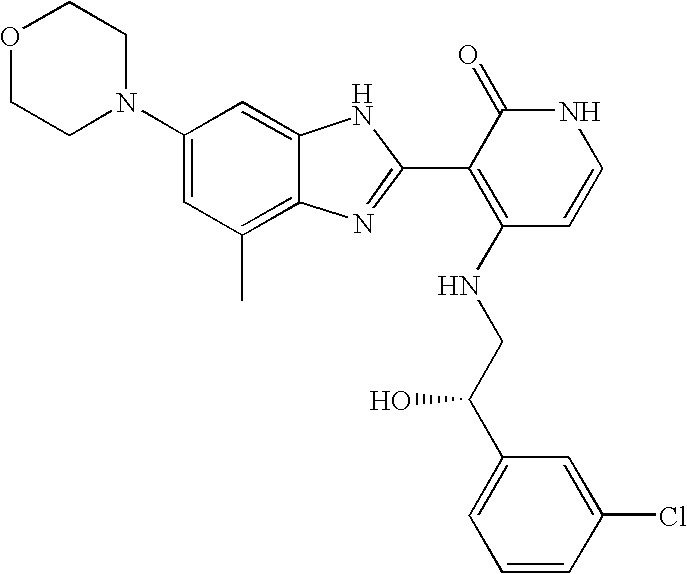Biomarkers and methods for determining sensitivity to insulin growth factor-1 receptor modulators
- Summary
- Abstract
- Description
- Claims
- Application Information
AI Technical Summary
Benefits of technology
Problems solved by technology
Method used
Image
Examples
example 1
Identification of Biomarkers
Methods and Materials
Cell Lines:
[0082]All pediatric sarcoma and neuroblastoma cell lines were obtained from Dr. Lee Helman at NIH. All cell lines were grown in RPMI medium supplemented with Glutamax (Gibco / Invitrogen #61870-036), 10% inactivated fetal bovine serum (Gibco / Invitrogen #16140-071), 10 mM Hepes, penicillin and streptomycin. For the baseline profiling study, cells were harvested at 70-80% confluence; and for drug treatment study, two rhabdomyosarcoma (RMS) cell lines Rh36 and Rh41 were treated with 0.35 μM compound 1 for 6, 36 and 72 hours before harvest. To develop the compound 1-resistant RD1, the sensitive RD-1 cells (IC50=0.238 μM to compound 1) were first exposed to the dug at the IC50 concentration and passed as the cultures reached 70-80% confluence. The concentration of compound 1 was increased gradually every other culture passage and the IC50 value for the compound in these cells was measured periodically during this treatment time un...
example 2
Production of Antibodies Against the Biomarkers
[0122]Antibodies against the biomarkers can be prepared by a variety of methods. For example, cells expressing an biomarker polypeptide can be administered to an animal to induce the production of sera containing polyclonal antibodies directed to the expressed polypeptides. In one aspect, the biomarker protein is prepared and isolated or otherwise purified to render it substantially free of natural contaminants, using techniques commonly practiced in the art. Such a preparation is then introduced into an animal in order to produce polyclonal antisera of greater specific activity for the expressed and isolated polypeptide.
[0123]In one aspect, the antibodies of the invention are monoclonal antibodies (or protein binding fragments thereof). Cells expressing the biomarker polypeptide can be cultured in any suitable tissue culture medium, however, it is preferable to culture cells in Earle's modified Eagle's medium supplemented to contain 10...
example 3
Immunofluorescence Assays
[0126]The following immunofluorescence protocol may be used, for example, to verify IGF1R biomarker protein expression on cells or, for example, to check for the presence of one or more antibodies that bind IGF1R biomarkers expressed on the surface of cells. Briefly, Lab-Tek II chamber slides are coated overnight at 4° C. with 10 micrograms / milliliter (μg / ml) of bovine collagen Type II in DPBS containing calcium and magnesium (DPBS++). The slides are then washed twice with cold DPBS++ and seeded with 8000 CHO-CCRS or CHO pC4 transfected cells in a total volume of 125 μl and incubated at 37° C. in the presence of 95% oxygen / 5% carbon dioxide.
[0127]The culture medium is gently removed by aspiration and the adherent cells are washed twice with DPBS++ at ambient temperature. The slides are blocked with DPBS++ containing 0.2% BSA (blocker) at 0-4° C. for one hour. The blocking solution is gently removed by aspiration, and 125 μl of antibody containing solution (a...
PUM
 Login to View More
Login to View More Abstract
Description
Claims
Application Information
 Login to View More
Login to View More - R&D
- Intellectual Property
- Life Sciences
- Materials
- Tech Scout
- Unparalleled Data Quality
- Higher Quality Content
- 60% Fewer Hallucinations
Browse by: Latest US Patents, China's latest patents, Technical Efficacy Thesaurus, Application Domain, Technology Topic, Popular Technical Reports.
© 2025 PatSnap. All rights reserved.Legal|Privacy policy|Modern Slavery Act Transparency Statement|Sitemap|About US| Contact US: help@patsnap.com


